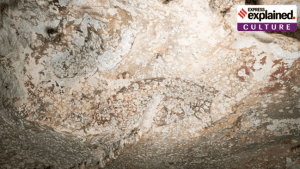TAG: GS 1: ART AND CULTURE
THE CONTEXT: A recent study has unveiled the world’s oldest known figurative cave painting, dating back 51,200 years.
EXPLANATION:
- This groundbreaking discovery, located in the Leang Karampuang cave on the Indonesian island of Sulawesi, surpasses the previous record-holder by over 5,000 years.
- The painting depicts a wild pig and three part-human, part-animal stick figures, providing significant insights into the early origins of human artistic expression.
The Study and Its Findings
- The study, titled “Narrative cave art in Indonesia by 51,200 years ago,” was published in the journal Nature on July 3, 2023,
- It was conducted by a team of 23 researchers from Griffith University, Southern Cross University, and the Indonesian National Research and Innovation Agency.
- Although the samples were collected in 2017, they were not dated until earlier this year using a new dating technique.
Description of the Painting
- The painting features a pig with its mouth partially open, accompanied by three therianthropes (part-human, part-animal stick figures):
- Figure 1: Appears to be holding an object near the pig’s throat.
- Figure 2: Positioned upside-down above the pig’s head with legs splayed out.
- Figure 3: Larger and grander, holding an unidentified object and possibly wearing an elaborate headdress.
- The depiction suggests a dynamic scene, potentially narrating a story involving human-animal interaction.

A painting created at least 51,200 years ago in the limestone cave of Leang Karampuang in the Maros-Pangkep region of the Indonesian island of Sulawesi portrays three human-like figures interacting with a wild pig, in this undated handout image.
Significance of the Painting
- The researchers emphasized that this discovery pushes back the known timeline of figurative art in human history.
- The painting demonstrates that early Homo sapiens engaged in complex image-making and storytelling through art much earlier than previously recognized.
- While Neanderthals, considered the closest ancient human relatives, began marking caves around 75,000 years ago, their markings were typically non-figurative.
- The Sulawesi cave art’s figurative nature indicates that Homo sapiens developed a rich culture of storytelling and scenic representation much earlier in this region compared to Europe.
The New Dating Technique
- The researchers utilized uranium series (U-series) analysis of calcite deposits overlying the rock art in limestone caves.
- Laser beams were employed to compare the ratio between the parent isotope (uranium) and the daughter isotope (thorium).
- This technique enabled precise dating of the paintings.
- Using this method, the researchers also re-dated another hunting scene at Leang Bulu’ Sipong 4, initially estimated to be 43,900 years old.
- The new findings suggest it is at least 4,000 years older, further emphasizing the accuracy and significance of the U-series dating technique.
Implications for Archaeology
- This discovery underscores the importance of integrating scientific methods with archaeological research.
- In regions like India, where abundant rock art exists (e.g., in Madhya Pradesh), such precise dating techniques have not been widely applied.
- The Sulawesi painting’s dating highlights the potential for new insights into the early history of human artistic expression globally.
SOURCE: https://indianexpress.com/article/explained/explained-culture/world-oldest-cave-art-9434758/
Spread the Word
